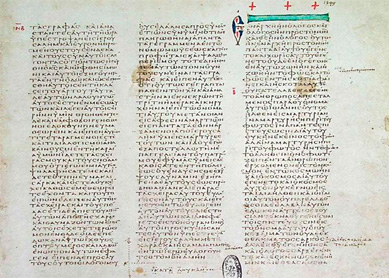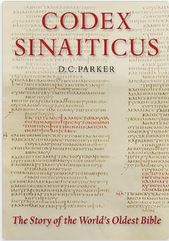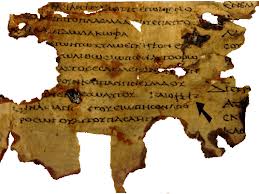The New Testament came into being over a long period of time. Before there was the printed Bible as we know it, scrolls and manuscript fragments were scattered from the East to the West, copied from earlier sources by scribes, or translated from material in different languages. Inevitably, textual changes and errors crept into the tradition: some were corrected, others perpetuated, with the result that scholars, editors, and translators are faced with thousands of textual variants. For example, one manuscript of
J. A. Bengel, an eighteenth-century scholar, was one of the pioneers who took on the task of sorting out the wealth of source materials in order to reconstruct the earliest text of the New Testament: manuscripts; ancient translations into Latin, Coptic, and Syriac; and the many citations of the New Testament by Christian authors (church fathers) like Origen, John Chrysostom, Jerome, and Augustine. Since the relationship between these varied textual witnesses was (and is) so complex, Bengel divided them into groups that he called “nations” and ”families.”
Later in the eighteenth century, J. S. Semler and J. J. Griesbach refined Bengel’s scheme by connecting these textual groupings to geographical areas where the text might have been revised (apart from the normal copying). The divisions were as follows: Alexandrian (used by the famous Christian intellectual Origen); Western (Latin translations); and Eastern (used by Antiochian and Constantinopolitan churches). Griesbach added the fourth-century Codex Vaticanus, as well as additional Alexandrian church fathers, to the Alexandrian text type. The work required a keen understanding of language and an eye for detail; texts were grouped with others based on the presence (or absence) of certain words or phrases, and in a couple of cases, entire passages—the famous Gospel pericope of the adulteress (
The two Cambridge professors, B. F. Westcott and F. J. A. Hort, preferred to label the ancestor of the Alexandrian text type the “Neutral text,” meaning that it was relatively unchanged and successively became the more corrupt type of text that they identified as the Alexandrian text. The so-called Neutral text, chiefly represented by the fourth-century codices Vaticanus and Sinaiticus, formed the basis of their The New Testament in the Original Greek (1881). This edition—which in Westcott and Hort’s view represented the most accurate and authentic version of the New Testament in the original language available in their day—furnished the death blow to the traditional text published by Erasmus in 1516, also known as Textus Receptus (the “received text”), which had dominated Greek editions and, indirectly, Bible translations (most famously the King James Version) for hundreds of years.
Although the theory of text types still prevails in current text-critical practice, some scholars have recently called to abandon the concept altogether in light of new computer-assisted methods for determining manuscript relationships in a more exact way. To be sure, there is already a consensus that the various geographic locations traditionally assigned to the text types are incorrect and misleading. Thus, “Western text” is not the only misnomer: the geographical labels of the other text types should be considered with suspicion, too. Some scholars prefer to refer to the text types as “textual clusters.”
Bibliography
- Houghton, H. A. G. “Recent Developments in New Testament Textual Criticism.” Early Christianity 2. 2 (2011): 245–68.
- Hull, Robert F. Jr. The Story of the New Testament Text: Movers, Materials, Motives, Methods, and Models. Resources for Biblical Study 58. Atlanta: Society of Biblical Literature, 2010.
- Epp, Eldon J. “Textual Clusters: Their Past and Future in New Testament Textual Criticism.” Pages 519–77 in The Text of the New Testament in Contemporary Research: Essays on the Status Quaestionis. Edited by Bart D. Ehrman and Michael W. Holmes. 2d ed. New Testament Tools, Studies, and Documents 42. Leiden: Brill, 2013.





